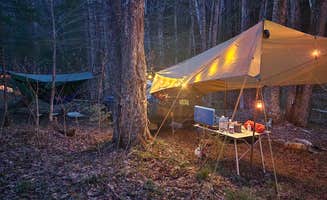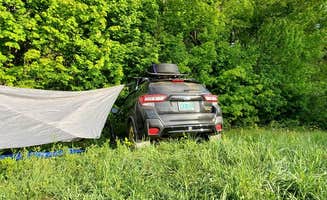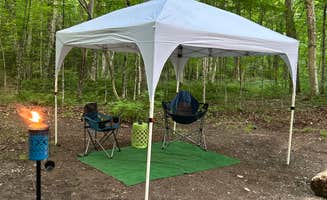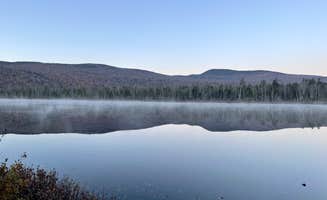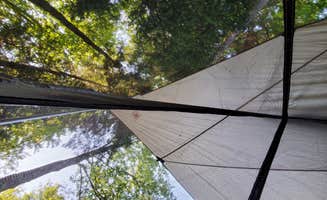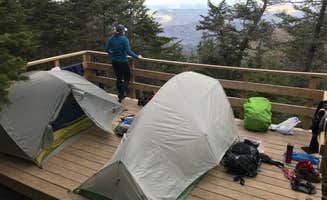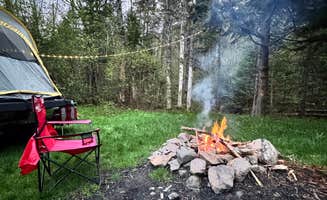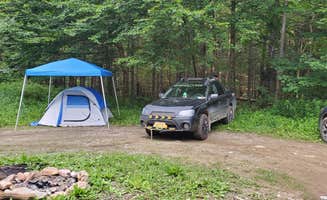Dispersed camping near Vershire, Vermont offers primitive sites primarily within Green Mountain National Forest at elevations of 1,000-2,000 feet. The area experiences cold winters with heavy snowfall from November through April, and short but mild summers that attract black flies from May to July. Most forest roads close during winter and spring thaw, with the camping season typically running from late May through October.
What to do
Swimming opportunities: At Austin Brook (Warren Falls), campers can access swimming holes directly from their sites. According to one visitor, "There's a few sites here! All pretty much have access to the streams. Nice fire rings. Keep it clean!" These sites combine camping and water access in one location.
Hiking trails: Near Green Mountain National Forest FR207, hikers can connect to the Appalachian Trail system. A camper notes, "Nearby Clark Brook Trail is a 3 mile hike connecting with the AT/LT." This provides multi-day backpacking options from your campsite.
Wildlife viewing: Winter camping at FR207 offers unique opportunities for wildlife spotting. One winter camper shared, "Woke up to two moose nearby the morning I was leaving." Early mornings and dusk provide the best viewing times for wildlife throughout the forest.
What campers like
Riverside camping: The Patterson Brookside camp offers water-adjacent sites that campers value. A visitor describes, "Mountain road lingers along the river. There's quite a few sites along the road. Be sure to camp at spots with established fire rings!" The sound of flowing water adds to the camping experience.
Scenic views: Many sites at Green Mountain Camp on Town Road 11 feature mountain panoramas. One camper shares, "The scenic beauty of this place is amazing... There are wide open views of 3 mountain ranges. There are many flowering plants, wild apple trees on the right side of the road." These elevated meadow sites provide expansive vistas.
Seasonal experiences: Each season offers different camping opportunities. A winter visitor to FR207 reported, "My first time winter camping and had the entire area to myself. Beautiful sunsets, night skies and scenery. Extremely calm and peaceful." Camping outside peak summer months means fewer people and different natural experiences.
What you should know
Vehicle requirements: Many forest roads demand appropriate vehicles. At Green Mountain National Forest FR25, the road conditions can be challenging. One camper warned about theft risk: "Make sure to lock you valuables. Our Jackery, Solar panels & toilet were stolen."
Campsite selection timing: Dispersed sites fill quickly on weekends. For Elbow Pond Road, a visitor noted, "Drove in on a Wednesday afternoon and drove past 4 or 5 sites, which were all occupied." Midweek arrival improves your chances of finding available sites.
Environmental concerns: Some areas face closure risks due to misuse. At Patterson Brookside, a camper observed, "This area is being heavily use and some spots are being shut down from abuse, please be aware that you have a lot of impact, and that impact can be positive or negative. Choose Positive!" Practicing Leave No Trace principles helps preserve these free camping areas.
Tips for camping with families
Site accessibility: For families, choose sites with easier access. A visitor to Texas Falls Primitive campsites shared, "Past the gate at the end of the Texas Falls recreation area we found several sites with only a fire pit along the brook." These walk-in sites require less rugged driving but more carrying of gear.
Wildlife education: The forest provides opportunities for nature lessons. One camper at Green Mountain Camp mentioned, "Lots of birds, butterflies, and bees (they were not aggressive)." Bringing field guides helps children identify local species.
Weather preparation: Temperatures drop significantly at night even in summer. A camper at FR207 advised, "If you're considering a spot in Vermont to camp, come here! Also, make sure your car has a bit of clearance as some sports have dips in the ground." Pack extra layers for children, as mountain temperatures fluctuate widely.
Tips from RVers
Size limitations: Most dispersed sites accommodate smaller rigs only. At Austin Brook, a visitor observed, "Smaller area roughly 1-6 sites. When driving in on the right there's a culdesac type set up of sites... Road is short dead ends with a decent amount of turn around space." Trailers over 20 feet may struggle to find suitable sites.
Road conditions: Forest roads require careful navigation. A visitor to FR207 cautioned, "This is not a place to go without at least 9" of ground clearance." Many campers report difficulty accessing sites after rain when roads become muddy and rutted.
Leveling challenges: Sites rarely offer level parking. When visiting FR207, one RVer noted, "Great mountain views, some sites right on the road, some in fields and some tucked away out of view. The top end of the road has a few mud pits and may require some ground clearance from rocks." Bring leveling blocks and be prepared to position your vehicle carefully.


